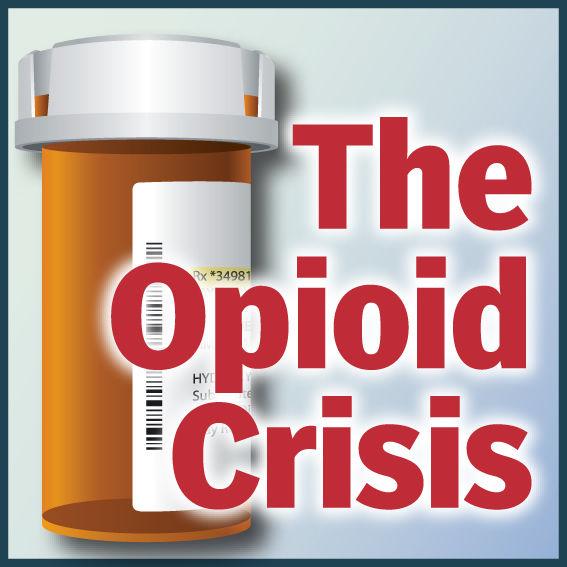Report outlines ‘road map’ for opioid treatment and recovery programs in Northeast Tennessee

As nine Northeast Tennessee counties continue to move forward with a lawsuit seeking to hold drug manufacturers responsible for the region’s opioid crisis, a recently unveiled report offers a preview of what kinds of treatment and recovery initiatives might be funded if localities win a judgment in the “Sullivan Baby Doe” case.
Expanded access to specialized services, medication-assisted treatment and long-term care are some of the ideas proposed in the plan authored by David Stern, a former vice-chancellor for health affairs at the University of Tennessee Health Science Center.
The report — prepared for a group of district attorneys general bringing the case, including Barry Staubus of Sullivan County — details what Stern describes as a “road map” for helping individuals grappling with opioid use disorder [OUD] transition into treatment and long-term recovery.
“Easy access to care is essential,” Stern wrote in his report, released in Sullivan County Circuit Court on Dec. 20. “Clients must be able to
receive services in a timely manner, administered by caregivers who understand opioid use disorder in addition to physical and mental health issues.”
Tennessee had one of the highest per capita opioid prescribing rates in the U.S., according to data Stern cites in his report. In 2011, for example, Sullivan County had 240.6 prescriptions per 100 residents (or 2.4 prescriptions per person). The national rate for that year was 80.9 per 100 persons.
Nationally, that number has declined to 58.7 prescriptions per 100 residents in 2017, but in Sullivan County, enough opioid prescriptions were dispensed that each person could have 1.4 prescriptions, according to data from the Centers for Disease Control and Prevention.
Stern’s report identifies barriers to treatment in the region and proposes a plan that he says, at capacity, could treat up to 10,000 people annually.
Named for a baby born in Sullivan County with neonatal abstinence syndrome, the “Baby Doe” suit was brought against opioid manufacturers and distributors in 2017 under Tennessee’s Drug Dealer Liability Act, which allows for the recovery of damages caused by illegal drug use, including the cost of treatment, rehabilitation and medical expenses. The suit alleges opioid producers flooded the region with highly addictive prescription drugs and profited from the sale of products that eventually entered an illegal black market.
As the case prepares to go to trial in May, the Sullivan County Circuit Court authorized the release of several documents earlier this month that detail a $2.4 billion, 15-year plan that attorneys general are proposing to address the epidemic. That cache of filings included Stern’s 145-page report.
Stern describes a number of barriers to care in Northeast Tennessee, writing that the area’s treatment gap for patients is “enormous.” Issues he cites for the region include a lack of capacity, accessibility of care, extremely limited use of medication-assisted treatment, lack of local expertise in addiction medicine, transportation, treatment costs and the stigma of opioid use disorder.
Still, he says the region has some “assets” when it comes to taking on the opioid epidemic. Preexisting, small-scale programs could be ramped up, and many local officials are “pragmatic and acknowledge that the traditional approach to addiction simply has not been effective,” he wrote. These officials, according to Stern, “are open to learning about proven methods from other regions and want to actively address the problem.”
One of the central features of Stern’s report is the creation of “nodes,” which would be sites that offer a “one-stop shop” for patients with specialized services and integrated care. These offices would focus on addiction, mental and physical health and case management for social determinants of health, like housing, transportation and employment. Staff at nodes would include physicians, therapists, social workers and nurse care managers, Stern wrote. Each node in Stern’s plan is designed to accommodate up to 1,200 patients.
Stern’s approach includes medication-assisted treatment, which involves utilizing one of three FDA-approved medicines and is usually accompanied by counseling. While leading public health officials have endorsed such treatment, Stern notes that it has not been “widely accepted” in Tennessee and that in some cases it can lead to issues of providers “selling” medication like buprenorphine to patients without considering other health factors. Critics say this results in a “pill for a pill,” but Stern argues his approach would “win market share” from these kinds of clinics.
But he admits medication-assisted treatment “is an important tool, not a ‘be-all, end all’ solution to the complicated, pervasive and deeply entrenched Northeast Tennessee opioid crisis.”
“The plan is called the Tennessee Recovery Enhanced Addiction Treatment (or ‘TREAT’) because the emphasis is on treating the whole patient to achieve long-term recovery,” he added. “It is much more than simply dispensing a medicine and sending a patient to therapy.”
The plan also proposes a range of other initiatives, like mobile community health teams, an emergency consultation line for healthcare providers, telemedicine, residential treatment centers and recovery housing. A team of “navigators,” under Stern’s plan, would play a role in connecting individuals to various services.
But Stern’s proposal and other ideas discussed in the recently released reports come with a steep price tag: One expert estimates the cost of programs at $2.4 billion. That figure, calculated by economist C. Scott Hemphill, notes that depending on how many patients receive treatment, costs over a 15-year period could range from $2 billion to $2.9 billion.
And, if the suit is successful, it’s unclear what damages may ultimately be awarded and what programs would be implemented.
Staubus, Sullivan County’s district attorney general, acknowledged this in an interview Friday but said the expert reports describe a “template” of what an effective regional response to the opioid crisis might look like.
“Not only do you lay out the extent of the problem and how it was created, but then there’s the second part, which is, if there is a [legal] judgment, how much should it be to take care of the problem that exists?” he said.
And the proposal described in Stern’s report looks at the opioid crisis from a more long-term perspective, Staubus said.
“This plan is not something that’s going to happen overnight, and it doesn’t provide recovery overnight. It would be a number of agencies and other facilities, a number of approaches,” he said.
The bankruptcy of one of the suit’s original defendants, Purdue Pharma, also poses a potential challenge in terms of what damages localities may be able to recover through litigation. This fall the OxyContin producer reached a tentative multibillion-dollar settlement with 24 state attorneys general, a group that includes Tennessee Attorney General Herbert Slatery III.
Mallinckrodt LLC, Endo Health Solutions Inc. and Endo Pharmaceuticals Inc. are the other drug makers named in the suit. A former doctor and two individuals, accused of having a role in diverting drugs to the illegal opioid drug market are also defendants.
 Pathways Drug Rehabilitation Luxury Addiction Treatment & Detox Center
Pathways Drug Rehabilitation Luxury Addiction Treatment & Detox Center




